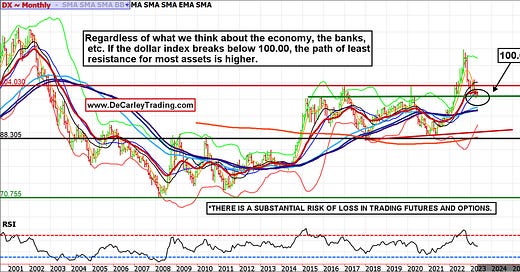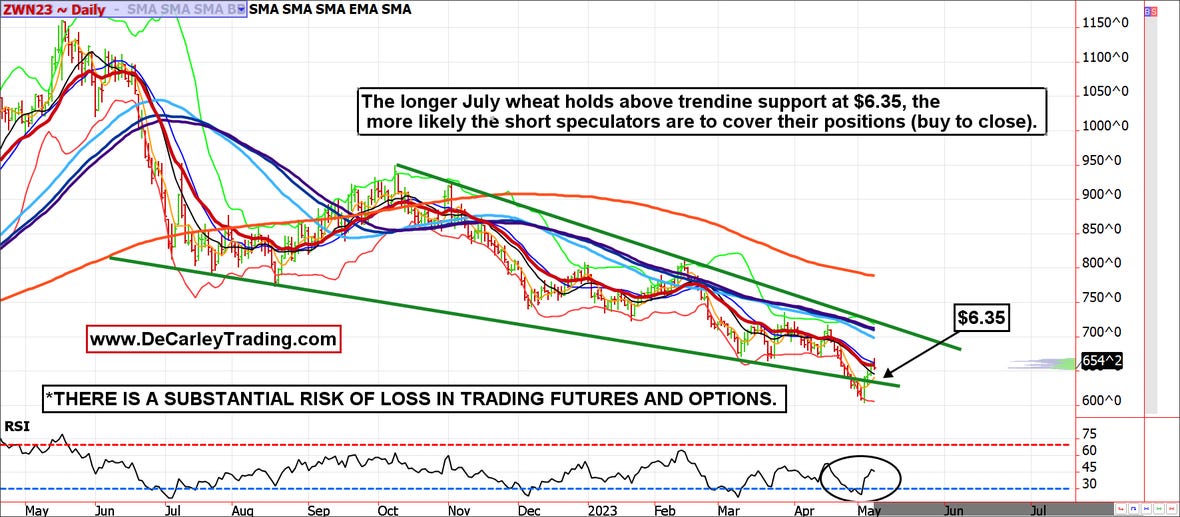As long as the Dollar remains Sluggish, the Path of Least Resistance is Higher for Most Assets
The US dollar index is consolidating after a significant slide, but attempted rallies haven’t been able to alter the downtrend.
The US dollar index is consolidating after a significant slide, but attempted rallies haven’t been able to alter the downtrend. While there are many moving parts, the general rule of thumb is that a weaker dollar should support most US-denominated assets. The Dollar peaked in October, around the same time the S&P 500 found its low; since then, both of these markets have been operating with a negative correlation, as expected. Yet, we haven’t seen energy or agricultural commodities behave as expected. In fact, crude oil, natural gas, and the grains have traded lower in lockstep with the Dollar.
At some point, probably sooner rather than later, commodities will need to be repriced higher to account for the discounted greenback. Further, stock indices will likely continue to benefit from the weaker US dollar, at least for now. In short, regardless of our opinion of the bank failures, the economy, or the Chinese reopening, if the dollar index melts through support near 100.00, the path of least resistance for most assets will be higher.
In the early 2000s, the dollar index entered a bear market that didn’t end until reaching the low 70.00s just before the financial crisis. It is not a coincidence that the bull markets in stocks and commodities ended at about the same time the US dollar was bottoming in 2008. Today’s dollar index valuation near 100.00 is still relatively expensive based on historical standards despite the significant correction. We are in the camp that the dollar index will see 98.00 sooner rather than later, and in the long run, we expect the low-90.00s to be in play. All else being equal, that alone would be a reason for risk assets to grind higher to climb the wall of worry.
Stock Indices
“Sell in May” hasn’t worked lately for the S&P 500. The last five years have generally seen steady low-volatility rallies during the summer doldrum period. With futures traders sitting on one of the largest net short positions in history, we must assume the short covering will fan the flames of a potential summer rally. Our initial target is 4270 in the June S&P 500, but a break above that level would get interesting. In a longer time horizon, months, not weeks, the next potential upside target could be 5070 (a monthly trendline).
Commodities
Some are pointing toward weakness in crude oil futures to justify a bearish stance in risk assets. However, the selling in oil last week can likely be explained by catching traders on the wrong foot rather than a real fundamental phenomenon. Those speculators who bought on the OPEC production cut news were stopped out, or spooked out, of positions on the way down, but they are scrambling to get those longs back on. Trader FOMO (Fear of Missing Out) is for good reason; along with support from the lower Dollar, OPEC has their mojo back. In early 2020, OPEC flushed the market to deter shale oil producer aggression, and it worked. OPEC, once again, acquired a significant influence over price, and $60.00ish oil is probably their pain threshold. According to longer-term charts, such as weekly and monthly, the low-$60.00s also provide trendline support.
The grains, specifically wheat, have mostly ignored the positive impact of a lower dollar on demand. Speculators have amassed significant net short positions in wheat futures, and to a lesser extent, corn. But unless the Dollar recovers, those products are, arguably, underpriced. According to the daily chart of July wheat futures, as long as $6.35 holds, prices should make their way toward $7.00. A break above $7.00 would suggest a trend change.
Conclusion
Amid the chaos, we need to get back to the basics. Correlations between currencies and assets can alter over time; however, a lower dollar works toward higher asset prices in the long run. If the Dollar breaks down further, it will be difficult for the S&P 500 to trade dramatically lower, and it could boost trend reversals in commodities that have been under pressure, such as energies and grains.
*There is substantial risk of loss in trading futures and options. There are no guarantees in speculation; most people lose money trading commodities. Past performance is not indicative of future results.
Seasonality is already factored into current prices, any references to such does not indicate future market action.
**There is substantial risk of loss in trading futures and options.** These recommendations are a solicitation for entering into derivatives transactions. All known news and events have already been factored into the price of the underlying derivatives discussed. From time-to-time persons affiliated with Zaner, or its associated companies, may have positions in recommended and other derivatives. Past performance is not indicative of future results. The information and data in this report were obtained from sources considered reliable. Their accuracy or completeness is not guaranteed. Any decision to purchase or sell as a result of the opinions expressed in this report will be the full responsibility of the person authorizing such transaction. Seasonal tendencies are a composite of some of the more consistent commodity futures seasonals that have occurred over the past 15 or more years. There are usually underlying, fundamental circumstances that occur annually that tend to cause the futures markets to react in similar directional manner during a certain calendar year. While seasonal trends may potentially impact supply and demand in certain commodities, seasonal aspects of supply and demand have been factored into futures & options market pricing. Even if a seasonal tendency occurs in the future, it may not result in a profitable transaction as fees and the timing of the entry and liquidation may impact on the results. No representation is being made that any account has in the past, or will in the future, achieve profits using these recommendations. No representation is being made that price patterns will recur in the future.








